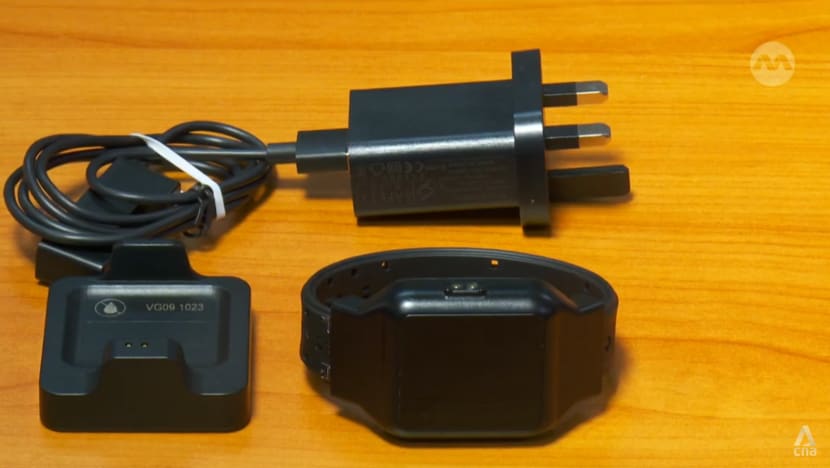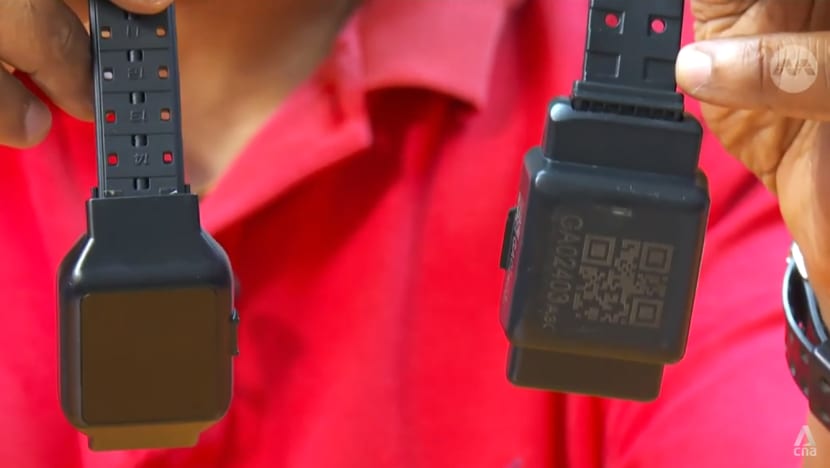New smartwatch-like tags aim to reduce stigma for offenders serving sentences in community
Inmates who often wear shorts or dresses, or wish to socialise without drawing attention, might prefer the wrist tag for its discreet nature.

The Singapore Prison Service's new smartwatch-like wrist tag is seen with its charging accessories. It can last up to 16 hours of usage when fully charged, according to the manufacturer.

This audio is generated by an AI tool.
SINGAPORE: The Singapore Prison Service (SPS) is rolling out new GPS-enabled wrist trackers for inmates serving their sentences in the community, in efforts to reduce the stigma associated with wearing ankle tags.
Those who often wear shorts or dresses, or wish to socialise without drawing unwanted attention, can use the wrist tag for its discreet nature instead of the traditional bulky ankle devices, said the SPS. It added that the wrist tags were first issued in 2022 as part of trials.
Such inmates - also known as supervisees - have to follow a strict curfew and be monitored as they work, study or engage in community work outside of prison. They are placed on community-based programmes towards the tail end of their sentences as they reintegrate into society.
Ankle tags will not be phased out, however. Depending on their profile, lifestyle and community-based programmes, supervisees will be assigned a suitable tag.
Deputy Assistant Commissioner (DAC) Jean Chiang, director of SPS’ logistics and finance division, told CNA that lowering the stigma faced by supervisees will let them gain confidence as they look for a job and socialise in the community.
“As they go to different places, like places of worship, they feel that they are accepted … and not seen in a different way (or) a different light,” added the former deputy director at SPS’ Community Corrections Command.
“A lot of them only wear long pants to hide the tag, and so looking from their perspective, we wanted to give them something that really normalises the tagging. So, that's why we had the idea of having a wrist tag instead.”
HELPING WITH REINTEGRATION
Ex-offender Bruce Mathieu, who now works as a motivational speaker, said the new wrist tags will be helpful in overcoming the stigma of being an inmate while they begin their reintegration into the community.
He said the existing ankle tags make inmates highly visible to the public while working in the community, potentially affecting their confidence.
"One of the major problems that ex-offenders have … is low self-esteem. Being out in society, trying to reintegrate, it's not an easy journey. We don't want society to judge us for our past … but more of what we are going to do with our life for the future,” he added.
Mr Thomas Tan, a lead engineer at the Home Team Science and Technology Agency’s (HTX) corrections and narcotics programme management centre, said that these new wrist tags are smaller in size and lighter in weight.
"Ankle tags are bulkier and heavier. It is (also) more obvious to the public,” he added.
MIMICKING A SMARTWATCH
Both types of tags share the same operating system and cost about the same to produce.
They can last up to 16 hours of usage when fully charged, according to manufacturer iWOW Technology.

The wrist tag can also be charged with a portable power bank while the wearer is on the move, said HTX’s Mr Tan.
For inmates involved in sporting activities, the traditional ankle tag is tougher and more durable, according to Mr Michael James, a technician at iWOW Technology.
"You can do swimming, Muay Thai or even soccer with it. (It) shouldn't be a problem. The (wrist tag) is a little more fragile because it is worn on the wrist,” he added.
However, Mr Mathieu, who previously spent around two decades in prison for drug offences, said that while the wrist tag is an improvement, the design of its strap makes it obvious that it is not a watch. He hoped that the SPS could improve on that aspect.
SPS’ DAC Chiang said that while feedback from inmates has been positive so far, further trials of the wrist tag will be conducted with a larger group of supervisees to get feedback in order to enhance its design.
















